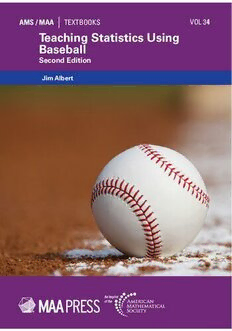Table Of ContentAMS / MAA TEXTBOOKS VOL 34
Teaching Statistics Using
Baseball
Second Edition
Jim Albert
Teaching Statistics Using
Baseball
Second Edition
Originallypublishedby
TheMathematicalAssociationofAmerica,2017.
SoftcoverISBN:978-1-4704-6938-2
LCCN:2017931120
Copyright©2017,heldbytheAmericanMathematicalSociety
PrintedintheUnitedStatesofAmerica.
ReprintedbytheAmericanMathematicalSociety,2022
TheAmericanMathematicalSocietyretainsallrights
exceptthosegrantedtotheUnitedStatesGovernment.
⃝1Thepaperusedinthisbookisacid-freeandfallswithintheguidelines
establishedtoensurepermanenceanddurability.
VisittheAMShomepageathttps://www.ams.org/
1098765432 272625242322
AMS/MAA TEXTBOOKS
VOL 34
Teaching Statistics Using
Baseball
Second Edition
Jim Albert
CouncilonPublicationsandCommunications
JenniferJ.Quinn,Chair
CommitteeonBooks
JenniferJ.Quinn,Chair
MAATextbooksEditorialBoard
StanleyE.Seltzer,Editor
BelaBajnok
MatthiasBeck
RichardE.Bedient
OttoBretscher
HeatherAnnDye
WilliamGreen
CharlesR.Hampton
JacquelineA.Jensen-Vallin
SuzanneLynneLarson
JohnLorch
VirginiaA.Noonburg
SusanF.Pustejovsky
JeffreyL.Stuart
MAATEXTBOOKS
BridgetoAbstractMathematics,RalphW.Oberste-Vorth,AristidesMouzakitis,andBonitaA.
Lawrence
CalculusDeconstructed:ASecondCourseinFirst-YearCalculus,ZbigniewH.Nitecki
CalculusfortheLifeSciences:AModelingApproach,JamesL.CornetteandRalphA.Ackerman
Combinatorics:AGuidedTour,DavidR.Mazur
Combinatorics:AProblemOrientedApproach,DanielA.Marcus
CommonSenseMathematics,EthanD.BolkerandMauraB.Mast
ComplexNumbersandGeometry,Liang-shinHahn
ACourseinMathematicalModeling,DouglasMooneyandRandallSwift
CryptologicalMathematics,RobertEdwardLewand
DifferentialGeometryanditsApplications,JohnOprea
DistillingIdeas:AnIntroductiontoMathematicalThinking,BrianP.KatzandMichaelStarbird
ElementaryCryptanalysis,AbrahamSinkov
ElementaryMathematicalModels,DanKalman
AnEpisodicHistoryofMathematics:MathematicalCultureThroughProblemSolving,Steven
G.Krantz
EssentialsofMathematics,MargieHale
FieldTheoryanditsClassicalProblems,CharlesHadlock
FourierSeries,RajendraBhatia
GameTheoryandStrategy,PhilipD.Straffin
GeometryIlluminated:AnIllustratedIntroductiontoEuclideanandHyperbolicPlaneGeome-
try,MatthewHarvey
GeometryRevisited,H.S.M.CoxeterandS.L.Greitzer
GraphTheory:AProblemOrientedApproach,DanielMarcus
AnInvitationtoRealAnalysis,LuisF.Moreno
KnotTheory,CharlesLivingston
Learning Modern Algebra: From Early Attempts to Prove Fermat’s Last Theorem, Al Cuoco
andJosephJ.Rotman
TheLebesgueIntegralforUndergraduates,WilliamJohnston
LieGroups:AProblem-OrientedIntroductionviaMatrixGroups,HarrietPollatsek
MathematicalConnections:ACompanionforTeachersandOthers,AlCuoco
MathematicalInterestTheory,SecondEdition,LeslieJaneFedererVaalerandJamesW.Daniel
MathematicalModelingintheEnvironment,CharlesHadlock
MathematicsforBusinessDecisionsPart1:ProbabilityandSimulation(electronictextbook),
RichardB.ThompsonandChristopherG.Lamoureux
MathematicsforBusinessDecisionsPart2:CalculusandOptimization(electronictextbook),
RichardB.ThompsonandChristopherG.Lamoureux
MathematicsforSecondarySchoolTeachers,ElizabethG.Bremigan,RalphJ.Bremigan,and
JohnD.Lorch
TheMathematicsofChoice,IvanNiven
TheMathematicsofGamesandGambling,EdwardPackel
MathThroughtheAges,WilliamBerlinghoffandFernandoGouvea
NoncommutativeRings,I.N.Herstein
Non-EuclideanGeometry,H.S.M.Coxeter
NumberTheoryThroughInquiry,DavidC.Marshall,EdwardOdell,andMichaelStarbird
OrdinaryDifferentialEquations:fromCalculustoDynamicalSystems,V.W.Noonburg
APrimerofRealFunctions,RalphP.Boas
ARadicalApproachtoLebesgue’sTheoryofIntegration,DavidM.Bressoud
ARadicalApproachtoRealAnalysis,2ndedition,DavidM.Bressoud
RealInfiniteSeries,DanielD.BonarandMichaelKhoury,Jr.
TeachingStatisticsUsingBaseball,2ndedition,JimAlbert
ThinkingGeometrically:ASurveyofGeometries,ThomasQ.Sibley
TopologyNow!,RobertMesserandPhilipStraffin
UnderstandingourQuantitativeWorld,JanetAndersenandToddSwanson
Contents
PrefacetotheFirstEdition ix
PrefacetotheSecondEdition xi
1 AnIntroductiontoBaseballStatistics 1
2 ExploringaSingleBatchofBaseballData 13
2.1 LookingatTeams’OffensiveStatistics..................................................... 13
2.2 ATributetoDerekJeter........................................................................ 17
2.3 ATributetoRandyJohnson................................................................... 20
2.4 AnalyzingBaseballAttendance............................................................... 23
2.5 ManagerStatistics:theUseofSacrificeBunts............................................ 26
2.6 Exercises........................................................................................... 28
3 ComparingBatchesandStandardization 45
3.1 AlbertPujolsandMannyRamirez........................................................... 45
3.2 RobinRobertsandWhiteyFord.............................................................. 50
3.3 HomeRuns:AComparisonofFourSeasons.............................................. 54
3.4 SluggingPercentagesareNormal............................................................ 57
3.5 GreatBattingAverages......................................................................... 59
3.6 Exercises........................................................................................... 61
4 RelationshipsBetweenMeasurementVariables 73
4.1 RelationshipsinTeamOffensiveStatistics................................................. 73
4.2 RunsandOffensiveStatistics.................................................................. 78
4.3 MostValuableHittingStatistics.............................................................. 80
4.4 ANewMeasureofOffensivePerformance................................................ 86
4.5 HowImportantisaRun?....................................................................... 88
4.6 BaseballPlayersRegresstotheMean....................................................... 91
4.7 Exercises........................................................................................... 94
vii
viii Contents
5 IntroductiontoProbabilityUsingTabletopGames 111
5.1 WhatisChrisDavis’HomeRunProbability?............................................. 111
5.2 BigLeagueBaseball............................................................................. 114
5.3 All-StarBaseball................................................................................. 116
5.4 Strat-O-MaticBaseball......................................................................... 119
5.5 Exercises........................................................................................... 124
6 ProbabilityDistributionsandBaseball 139
6.1 TheBinomialDistributionandHitsperGame............................................ 139
6.2 ModelingRunsScored:GettingonBase................................................... 142
6.3 ModelingRunsScored:AdvancingtheRunnerstoHome.............................. 144
6.4 Exercises........................................................................................... 148
7 IntroductiontoStatisticalInference 155
7.1 AbilityandPerformance........................................................................ 155
7.2 SimulatingaBatter’sPerformanceifHisAbilityisKnown............................ 157
7.3 LearningAboutaBatter’sAbility............................................................ 159
7.4 IntervalEstimatesforAbility.................................................................. 161
7.5 ComparingWadeBoggsandTonyGwynn................................................. 165
7.6 Exercises........................................................................................... 168
8 TopicsinStatisticalInference 175
8.1 SituationalHittingStatisticsforMikeTrout............................................... 176
8.2 ObservedSituationalEffectsforManyPlayers........................................... 178
8.3 ModelingOn-BasePercentagesforManyPlayers........................................ 181
8.4 ModelsforSituationalEffects................................................................. 185
8.5 IsMichaelBrantleyStreaky?.................................................................. 188
8.6 AStreakyDie..................................................................................... 191
8.7 Exercises........................................................................................... 193
9 ModelingBaseballUsingaMarkovChain 211
9.1 IntroductiontoaMarkovChain............................................................... 211
9.2 AHalf-inningofBaseballasaMarkovChain............................................. 215
9.3 UsefulMarkovChainCalculations........................................................... 217
9.4 TheValueofDifferentOn-baseEvents..................................................... 222
9.5 AnsweringQuestionsAboutBaseballStrategy........................................... 224
9.6 Exercises........................................................................................... 225
A AnIntroductiontoBaseball 233
A.1 TheGameofBaseball........................................................................... 233
A.2 OneHalf-InningofBaseball................................................................... 234
A.3 TheBoxscore:AStatisticalRecordofaBaseballGame................................ 235
Bibliography 239
Index 241
Preface to the First Edition
Overtwentyyears,thisauthorhasbeenintheenterpriseofteachingintroductorystatisticstoan
audiencethatistakingtheclasstosatisfytheirmathematicsrequirement.Thisisachallenging
endeavor because the students have little prior knowledge about the discipline of statistics
and many of them are anxious about mathematics and computation. Statistical concepts and
examplesareusuallypresentedinaparticularcontext.However,oneobstacleinteachingthis
introductoryclassisthatweoftendescribethestatisticalconceptsinacontext,suchasmedicine,
law, or agriculture that is completely foreign to the undergraduate student. The student has a
muchbetterchanceofunderstandingconceptsinprobabilityandstatisticsiftheyaredescribed
inafamiliarcontext.
Manystudentsarefamiliarwithsportseitherasaparticipantoraspectator.Theyknowofthe
popularathletes,suchasTigerWoodsandBarryBonds,andtheyaregenerallyknowledgeable
withtherulesofthemajorsports,suchasbaseball,football,andbasketball.Formanystudents
sportsisafamiliarcontextinwhichaninstructorcandescribestatisticalthinking.
Thegoalofthisbookistoprovideacollectionofexamplesandexercisesapplyingproba-
bilityandstatisticstothesportofbaseball.Whybaseballinsteadofothersports?
(cid:4) BaseballisthegreatAmericangame.Baseballisgreatinthatithasarichhistoryofteams
andplayers,andmanypeoplearefamiliarwiththebasicrulesofthegame.Thepopularityof
baseball isreflected by thelarge number of movies thathave been produced about baseball
teamsandplayers.
(cid:4) Baseball is the most statistical of all sports. Hitters and pitchers are identified by their
correspondinghittingandpitchingstatistics.Forexample,BabeRuthisforeveridentifiedby
the statistic 60, which was the number of home runs hit in his 1927 season. Bob Gibson is
famous for his record low earned run average of 1.12 during the 1968 season. A flood of
differentstatisticalmeasuresareusedtorateplayersandsalariesofplayersaredeterminedin
partbythesestatistics.Thereisanactiveeffortamongbaseballwriterstolearnmoreabout
baseballissuesbyusingstatistics.
(cid:4) AwealthofbaseballdataiscurrentlyavailableovertheInternet.Playerandteamhittingand
pitchingstatisticscanbeeasilyfound.Comparisonsbetweenplayersofdifferenterascanbe
made using a downloadable dataset that gives hitting and pitching data for all players who
haveeverplayedprofessionalbaseball.
ix

